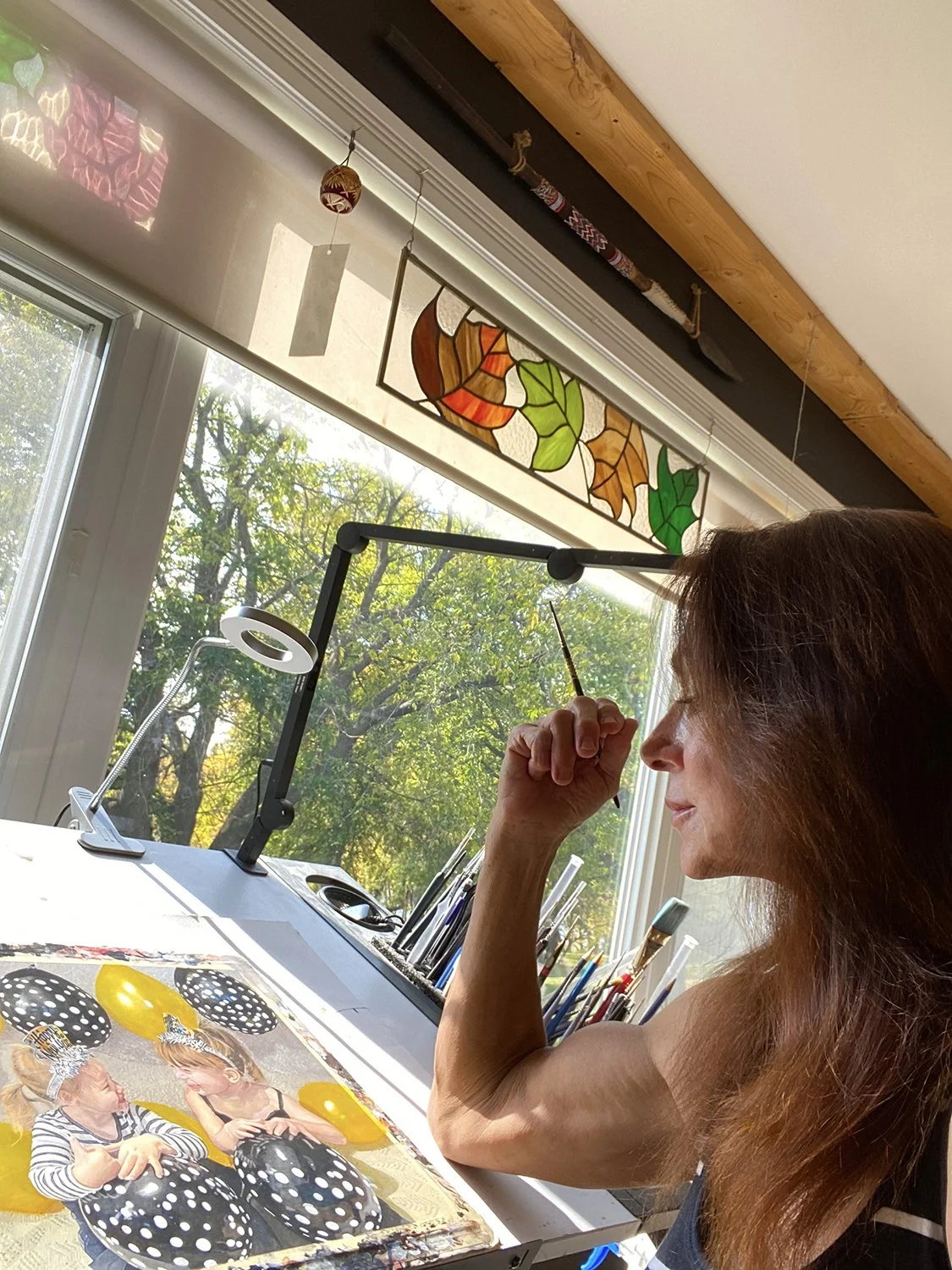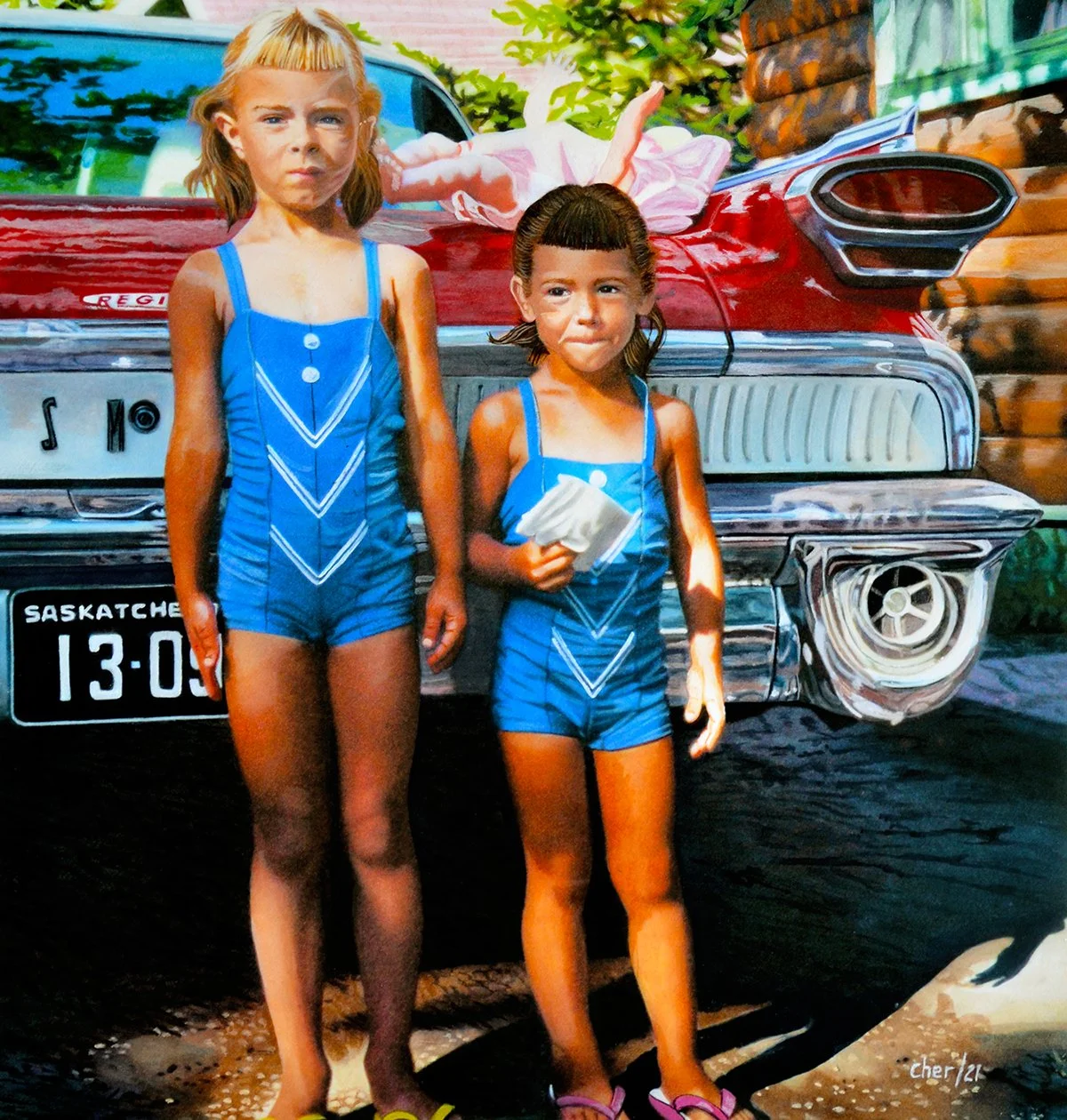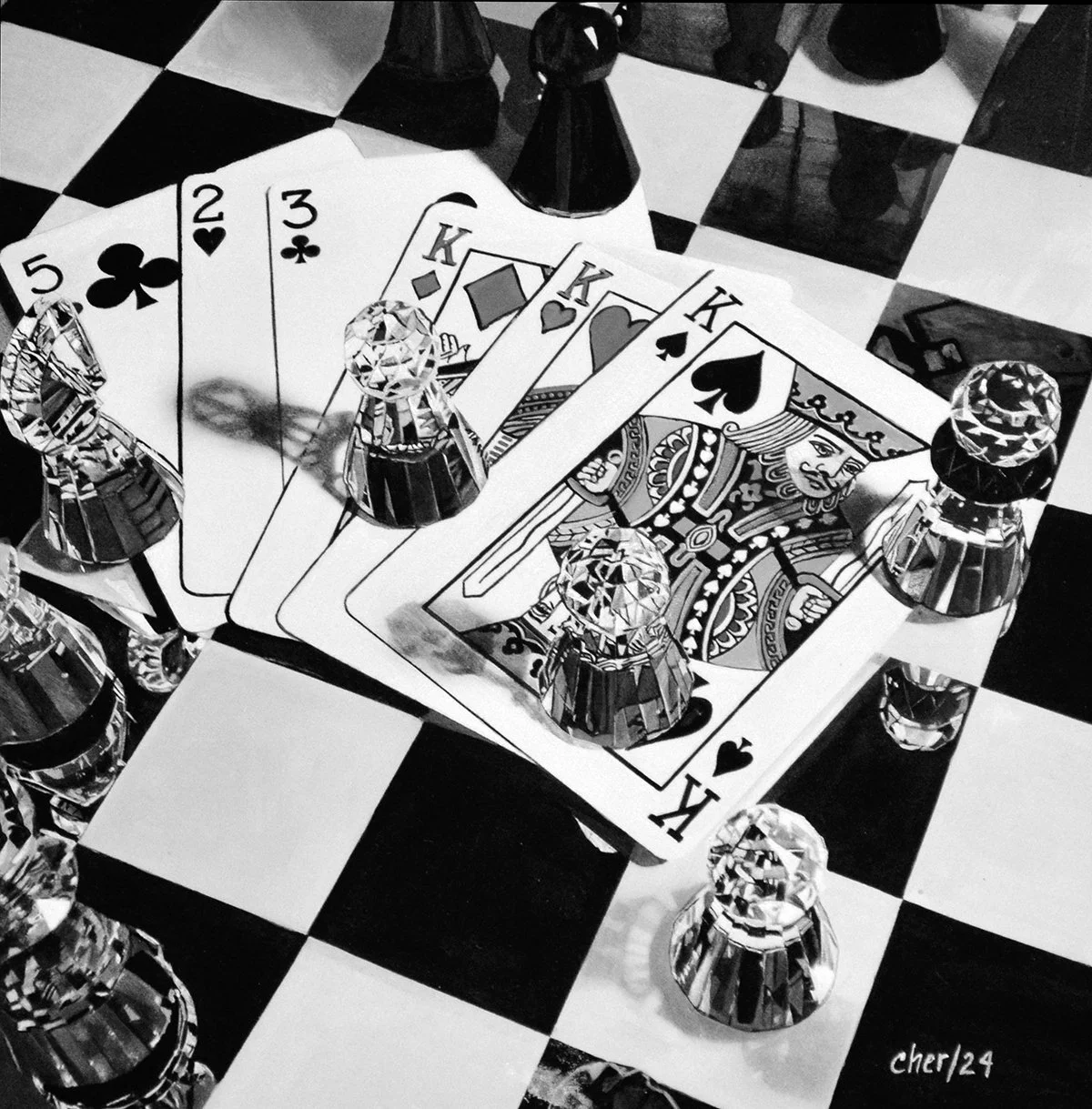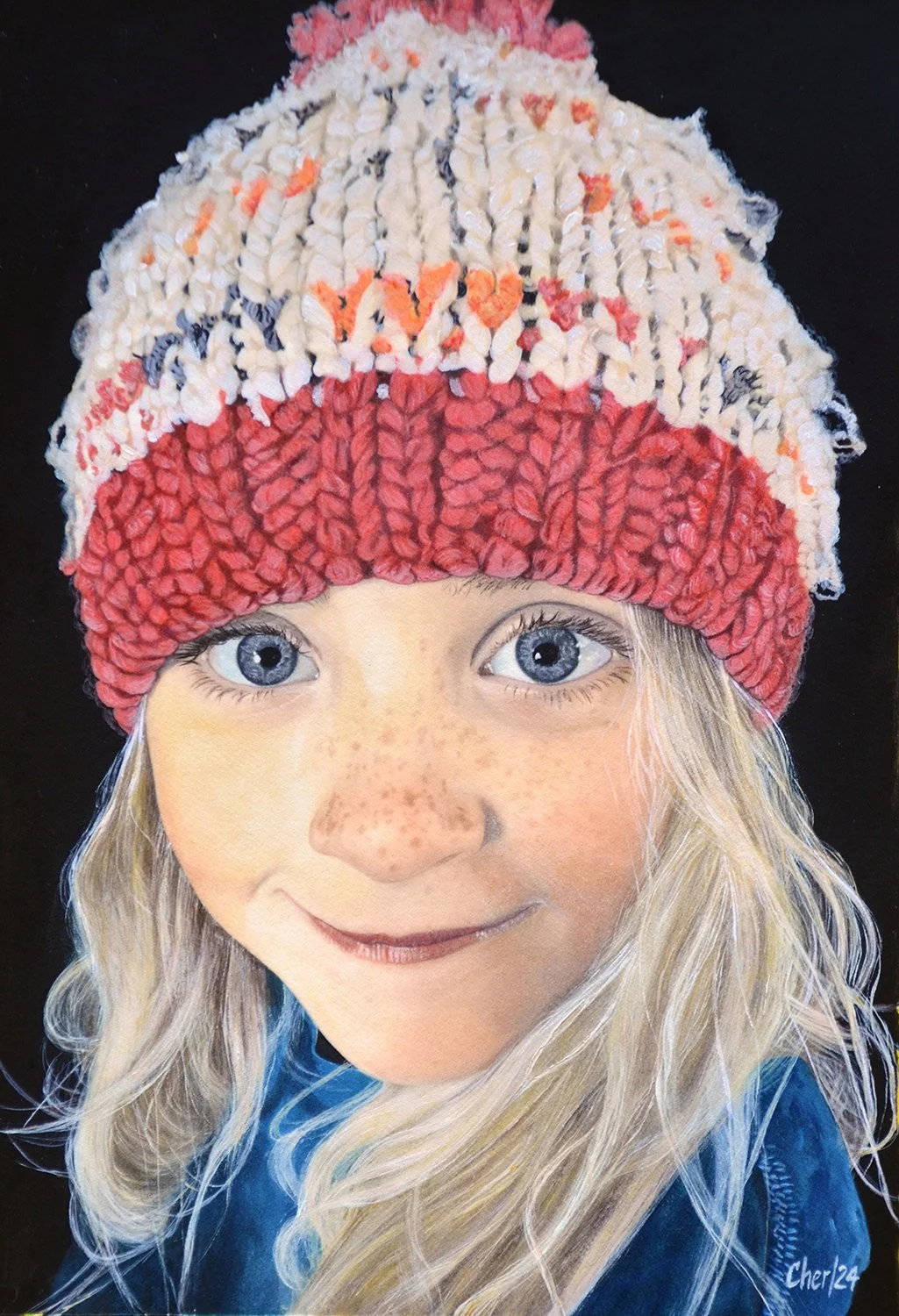Interview with Cher Pruys
Cher Pruys, ASAA SCA, IGOR, AAPL, CSAA, AMS, LMS, OSA, MAA, CFA, NOAPS, PSOA, AWA., AAOA.
"To take my inner visions with my hands and create a work of art for you the viewer .... That is the ultimate in self expression."
Cher Pruys was born in Regina. Over the years she lived in many places including Saskatoon, Calgary, Edmonton, Ottawa, Fort Frances, settling into her present home in Devlin, on the banks of the Rainy River with her husband Mark, 4 dogs and 2 cats.
By age three, Cher was seldom found without a drawing tool in hand. She worked in pencil, charcoal and ink over the years, until, she picked up a paintbrush at the age of 35. Beginning with oil paints, she found her chosen mediums in acrylic, water color and gouache.
Although self taught, her dedication and talent has seen her work juried into 626 International exhibits. She has won 969 awards for her work in the International Juried Exhibits.
Her work has graced the covers of 3 books, 38 magazines, including The Best Of Acrylic Fall 2021, cover of the May 2022 Arabella Magazine, #20 Hyperrealism Magazine with “Girls Girls Girls”, & #21 with “The Young Cowboy”, Artists & Illustrators March 2024 & the latest Artistonish 2024 July edition. She has been featured in over 450 International publications. Cher's works have found a permanent home in private and public collections worldwide.
Your artist statement mentions that creating art for the viewer is the ultimate form of self-expression. How do you reconcile the inherently personal nature of self-expression with the need to communicate and connect with an external audience through your work? Do you see a potential conflict between personal authenticity and public reception, and if so, how do you navigate it?
I truly feel that my artworks are the most rewarding and fulfilling way for me to communicate my inner thoughts and feelings with those around me. I have rarely felt conflict between my personal authenticity and the response of my audience so navigating around this has not been an issue. The fact that my subject matter is usually positive has factored in. The odd time it has arisen I realize that what is most important is to stay true to myself and my beliefs.
You draw inspiration from the seemingly mundane aspects of everyday life. How do you decide which ordinary moments are worthy of immortalization through your art, and what philosophical significance do you believe these moments hold? How do these chosen moments reflect your broader perspective on life and human experience?
Everyday moments really capture my attention. Ones that trigger memories or evoke a strong emotional reaction on my part quickly become my next obsession. By observing these often fleeting moments I notice that my views on life especially in terms of time and how little of it we as individuals each have, and also how ones own perspective overall can be narrow, I use them to spur growth in myself with a desire to enhance the human experience.
Having started with pencil, charcoal, and ink before transitioning to painting, how do you view your artistic evolution in terms of medium and style? How do these changes reflect your personal and philosophical growth over the years? Can you discuss specific milestones in your career where a change in medium or style signified a deeper transformation in your artistic vision?
Artistic evolution for me has evolved along with my choice of medium and style. From the beginning of my artistic journey when a crayon, then a pencil, then charcoal and pen and ink helped me to convey and express my inner thoughts and inner turmoil on paper the burning desire to include more substance in my work. I graduated to oil paints, dabbling in abstract which did present a freedom of flow I enjoyed, but chronic migraines made worse from the oil paint emissions and the recurring call for realism renderings helped my gravitation to water-based mediums. The joy I felt as I manipulated the water colors on my chosen surface and then the incredible control of the acrylics which lent itself fully to the finest details I desired were magic…I was hooked. My realism to photo realism to hyperrealism had begun.
As a self-taught artist who has achieved significant acclaim, how do you perceive the role of formal art education in the development of an artist? Do you believe that the absence of formal training has influenced your artistic vision and philosophy? In what ways has your self-directed learning journey shaped your creative process and artistic identity?
Being a self-taught artist rather than having experienced a formal art education has had its challenges. In a society where so much importance is placed on titles you can attach to your name achieving the success, respect and encouragement needed to reach that plateau can seem unsurmountable. That said technique can be taught…TALENT can not. Structure, good work ethics, dedication and desire make for a potent potion. I had been trained formally as a musician, so the groundwork was laid. I dedicated a number of years to bodybuilding which also required a strict adherence to structure as well as fulfilled a desire to observe and fully study and observe anatomy. I went through a lot of trial and error, but in the long run I was able to explore and develop my artistic identity to a most fulfilling degree without the constrains of formality.
Your work often blurs the line between realism and hyperrealism. How do you navigate the philosophical implications of creating art that is hyper-realistic yet fundamentally an illusion? What do you think this interplay between reality and illusion reveals about the nature of perception and truth in art and life?
I found realism didn’t quite satisfy my desired results, so I ventured into photo realism which was gratifying in detail but bland to me as it simply became an accurate reproduction of the image from which it was rendered. Hyperrealism which required such meticulous detail that it became not recognizable in the original subject matter, so it is still an illusion satisfied my craving. Thus, the perception is creating a depiction that the viewer finds so convincing of the reality that it is real in his eyes…and is this not true in both art and life?
You mention incorporating cultural and spiritual flavors into your art. Can you elaborate on how your cultural background and spiritual beliefs influence your artistic process and the themes you explore? How do you ensure that these elements resonate with a diverse audience, and what message do you hope to convey through them?
My cultural background was very Canadian – multicultural, polite, inclusive, diverse, tolerant, outdoorsy, community orientated and unfamiliar with violence and hate. Spirituality was and is very important to me in the sense that the acceptance of a higher power allows me to humble myself to the point I can find a sense of purpose. It fills me with hope, a deeper meaning of life and a strong desire for harmony. I did grow up in the tumultuous 70’s mind you, where social change really embraced women allowing us to embrace our sexuality and independence. The rise of women’s rights has given women artists the boost we needed to become admired and respected as we take our place in the art world.
You speak about manipulating reality to create illusionistic depth. How do you philosophically approach the concept of illusion in art, and what message do you hope to convey about reality and perception through your work? Do you see a parallel between the illusions in your art and the illusions we encounter in everyday life?
Technically speaking, manipulating reality to create illusionistic depth is of course achieved by linear perspective – setting your horizon line across your composition and placing your vanishing point along that line. All the lines that define the scale of a 3-dimensional element then converge on the same point and voila you have illusionistic depth! In my work, the concept of illusion is when my innermost thoughts are laid bare for the viewer, and this evokes an emotional response which connects the viewer to their own library of memories whereby the connection between my image and their own experiences is completed. Total SATISFACTION as an artist.
With numerous awards and recognitions to your name, how do you balance the external validation of your work with your internal artistic motivations? Do these accolades influence your creative process or philosophical outlook on art? How do you stay true to your artistic vision while navigating the pressures and expectations that come with such high levels of recognition?
Of course I feel grateful, humbled blessed and honoured that my works have garnished numerous awards. As a self-taught artist it is gratification and recognition that builds self esteem and self-confidence. I don’t feel any pressure to adapt my creative process or philosophical outlook on my work because of this as I am committed to staying true to myself and my visions as an artist. There is a pressure and expectations that demands each piece be as good or better than the one before when you reach this high level of recognition that does at times exhaust and drain one that can result in a dry period. When this happens I spend time in nature and with my animals and just let my mind run free.
In a world increasingly dominated by digital art and technology, how do you see the role of traditional painting mediums evolving? Do you believe there is a philosophical distinction between digital and traditional art forms? How do you think the rise of digital art affects the perception and value of traditional painting in contemporary culture?
I cannot compare traditional and digital art…they are so different. Digital art is a platform of its own which of course requires talent and skill to do well, but traditional art to me is such a spiritual hands-on process that cannot be replicated by use of machines. AI also has a place but the lack of soul in the pieces leaves it simply a rendition that is void of that human connection traditional art contains.
Given your extensive body of work and diverse subjects, how do you see your art as a reflection of your personal identity? In what ways do your paintings serve as a philosophical exploration of self and existence? How do the different subjects you choose to portray contribute to your understanding and expression of your own identity?
I see my art as the puzzle pieces of who I am. The memories of my life thus far that have accumulated to bring me to Cher today. I am able through my paintings of children go back and experience moments in time that had subtle or profound bearing on who I have become, and to recapture the magic in those moments, thus still feeling their impact. Some of my other subject matter such as In Retrospect gives pause to the clock as I take time to view my past years as a spectator. Sunday Morning reminds me to cherish my rituals and appreciate a little free time that I can use to regenerate myself.

















